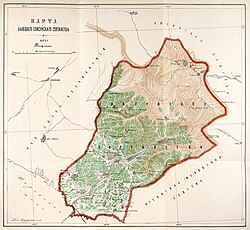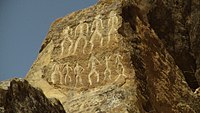
Qakh District is one of the 69 districts of Azerbaijan. It is located in the north of the country, in the Shaki-Zagatala Economic Region. The district borders the districts of Zagatala, Shaki, Samukh, Yevlakh, as well as the Kakheti region of Georgia and the Russian Republic of Dagestan. Its capital and largest city is Qakh. As of 2020, the district had a population of 57,200.

The Quba Khanate was one of the most significant semi-independent khanates that existed from 1747 to 1806, under Iranian suzerainty. It bordered Caspian sea to the east, Derbent Khanate to the north, Shaki Khanate to the west, and Baku and Shirvan Khanates to the south. In 1755 it captured Salyan from the Karabakh Khanate.

The Shaki Khanate was a khanate under Iranian and later Russian suzerainty, which controlled the town of Shaki and its surroundings, now located in present-day Azerbaijan.

Shirvan Khanate was a Caucasian khanate under Iranian suzerainty, which controlled the Shirvan region from 1761 to 1820.

The Tsakhur or Saxur people are a Lezgin sub-ethnic group of northern Azerbaijan and southern Dagestan (Russia). The group numbers around 30,000 people and are called yiqy, but are generally known by the name Tsakhur, which derives from the name of a Dagestani village, where they make up the majority.
Javad Khan Qajar ; c. 1748 – 1804) was a member Ziyadoghlu Qajar, a clan of the Qajar tribe, as well as the sixth and the last khan of the Ganja Khanate from 1786 to 1804 before it was lost to Russia.
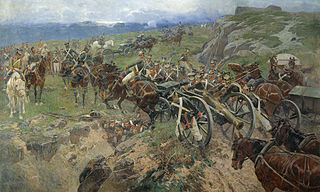
The Russian conquest of the Caucasus mainly occurred between 1800 and 1864. The Russian Empire sought to control the region between the Black Sea and Caspian Sea. South of the mountains was the territory that is modern Armenia, Azerbaijan, Georgia, and parts of Iran and Turkey. North of the mountains was the North Caucasus region of modern Russia. The difficult conquest of the intervening mountains is known as the Caucasian War. Multiple wars were fought against the local rulers of the regions, as well as the dominant powers, the Ottoman Empire and Qajar Iran, for control. By 1864 the last regions were brought under Russian control.
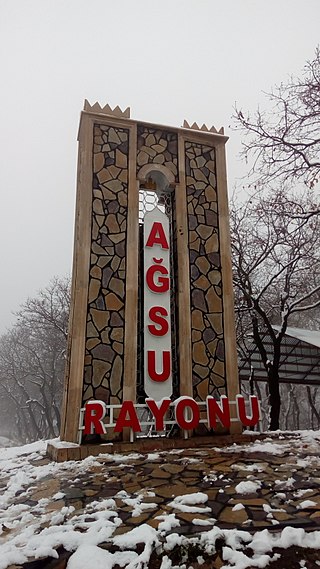
Agsu is a city in and capital of the Agsu District of Azerbaijan.
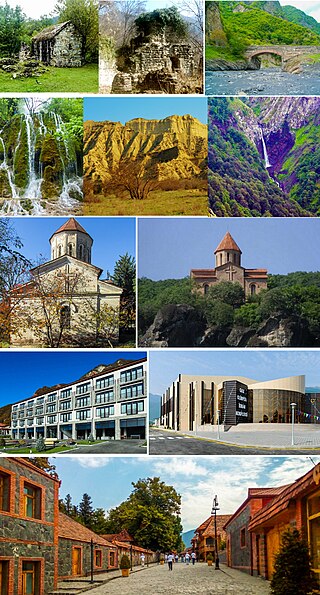
Qakh is the capital of the Qakh District in the north of Azerbaijan, near the Russian border.
Birinci Biləcik is a village and municipality in the Shaki Rayon of Azerbaijan. It lies in the Alazan-Ayrichay basin and has a population of 1,399.
Gazikumukh Khanate was a Lak state that was established in present-day Dagestan after the disintegration of Gazikumukh Shamkhalate in 1642. Its peoples included various Lezgin tribes and Avars.
Fatali Khan or Fath Ali Khan of Quba was a khan of the Quba Khanate (1758–1789) who also managed to dominate the Derbent, Baku, Talysh and Shirvan Khanates, as well as the Salyan Sultanate during much of his reign.
Shahverdi Khan Ziyadoghlu was the beylerbey of Karabakh from 1740 to 1743 and first khan of Ganja from 1747 to 1760. He was from the Ziyadoglu branch of the Qajar clan who ruled the Beylerbeylik of Karabakh as hereditary governors.
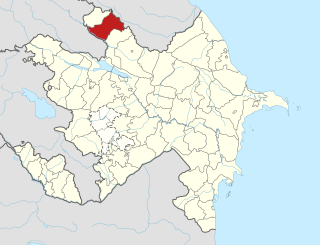
The Djaro-Belokani communities were a group of self-governing communities in the Caucasus from the 17th to the 19th centuries. They had close ties with the Elisu Sultanate to the southeast.
Mirza Muhammad Khan I was the founding Khan of the Baku Khanate. He was a descendant of the Iranian garrison commander of Baku of 1723.
Muhammad Husayn Khan Mushtaq, was the third khan of Shaki. He was described as a courageous but ruthless man by Abbasgulu agha Bakikhanov.
Arash Sultanate was a feudal fiefdom that existed between 1747-1795 in Transcaucasus. It comprised modern Aghdash, Yevlakh and Mingachevir raion of Azerbaijan.
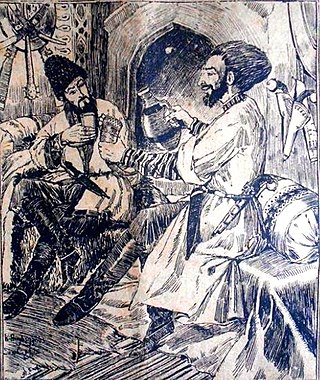
Umma Khan V Avar nicknamed Great or Mad — Avar nutsal, ruler of Avar Khanate from 1774 to 1801. Under Khan, the Avar Khanate expanded its borders both by subordinating the Avar free societies, and at the expense of neighboring territories. Khan was paid tributes by the Georgian king Erekle II, Derbent, Quba, Baku, Shirvan, Shaki khans and Akhaltsikhe pasha.
Surkhay Khan Kun-Butta or erroneously Khanbutai, Khon-Butai, Khomutai was an 18th-century Dagestani military leader as well as last independent Gazikumukh Khan.
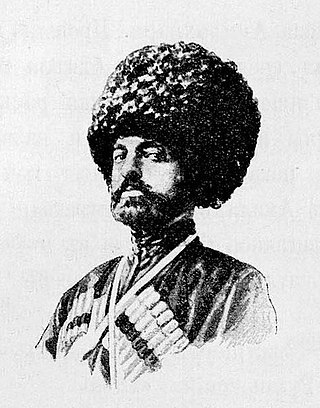
Daniyal Sultan or Daniyal Bek was an ethnic Tsakhur nobleman, general-major of the Imperial Russian Army and in Ottoman Army and the last ruler of Elisu Sultanate. He is best known to be one of the naibs (viceroy), relatives, as well as a member of the close circle of Imam Shamil.
This was abstracted from the Russian and Azerbaijani Wikipedia, there being no obvious source in English.
